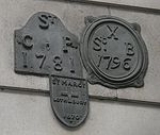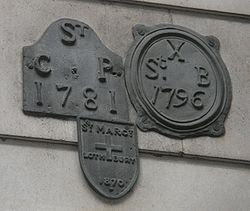
St Christopher le Stocks
Encyclopedia
St Christopher le Stocks was an parish church, situated on the south side of Threadneedle Street
in Broad Street Ward
of the City of London
.
. Endowments were bequeathed in 1427 and 1506. The church was burnt in the Great Fire of London
in 1666, and rebuilt by Sir Christopher Wren in 1671 using much of the surviving material, it was the first of his churches to be completed (Amery, 1988) at a cost of £2,098 12s 7d (Reynolds, 1922).
The church was demolished in 1782 (Hibbert,2008) to provide space for the extension of the Bank of England and the parish united with that of St Margaret Lothbury
in 1781 (Hallows, 1954). This was done to prevent an attack at night from St Christopher’s roof (Griffiths,1997).
The churchyard was also requisitioned in 1798, and now lies underneath the Bank’s
Garden Court. Partial burial records remain and are available for family history research.
A parish boundary mark (marking the boundary with that of St Bartholomew-by-the-Exchange
) can be seen on the front wall of the Bank of England
. A similar mark is visible on the Princes Street elevation of the Bank of England, but, in this instance, marking the boundary with St Margaret Lothbury
. The upper panels of the pulpit dating from Wren’s 1671 rebuilding survive at St. Nicholas Church Canewdon in Essex and are a fine specimen of carving of the Grinling Gibbons style.
The upper panels of the pulpit dating from Wren’s 1671 rebuilding survive at St. Nicholas Church Canewdon in Essex and are a fine specimen of carving of the Grinling Gibbons style.
. In common with all City of London parishes, St Christopher le Stocks has a serving parish clerk. St Christopher's clerk, is appointed by the rector and parochial church council of St Margaret, Lothbury. There are eight parish clerks serving at St Margaret, Lothbury, reflecting the eight united parishes.
Threadneedle Street
Threadneedle Street is a street in the City of London, leading from a junction with Poultry, Cornhill, King William Street and Lombard Street, to Bishopsgate....
in Broad Street Ward
Broad Street (ward)
Broad Street is one of the 25 ancient wards in the City of London.In mediaeval times it was divided into ten precincts and contained six churches, of which only two, St Margaret Lothbury and All Hallows-on-the-Wall now survive: St Bartholomew-by-the-Exchange was demolished in 1840, St Benet Fink...
of the City of London
City of London
The City of London is a small area within Greater London, England. It is the historic core of London around which the modern conurbation grew and has held city status since time immemorial. The City’s boundaries have remained almost unchanged since the Middle Ages, and it is now only a tiny part of...
.
History
The earliest reference to the church is in 1282 (Deacon, 1982). The origin of the name is disputed: Freshfield (1876) maintains it refers to the City Stocks, which at one time stood close to the church, but Huelin (1996) believes it to be a reference to the nearby Stock ExchangeStock exchange
A stock exchange is an entity that provides services for stock brokers and traders to trade stocks, bonds, and other securities. Stock exchanges also provide facilities for issue and redemption of securities and other financial instruments, and capital events including the payment of income and...
. Endowments were bequeathed in 1427 and 1506. The church was burnt in the Great Fire of London
Great Fire of London
The Great Fire of London was a major conflagration that swept through the central parts of the English city of London, from Sunday, 2 September to Wednesday, 5 September 1666. The fire gutted the medieval City of London inside the old Roman City Wall...
in 1666, and rebuilt by Sir Christopher Wren in 1671 using much of the surviving material, it was the first of his churches to be completed (Amery, 1988) at a cost of £2,098 12s 7d (Reynolds, 1922).
The church was demolished in 1782 (Hibbert,2008) to provide space for the extension of the Bank of England and the parish united with that of St Margaret Lothbury
St Margaret Lothbury
St. Margaret Lothbury is a Church of England parish church in the City of London; it spans the boundary between Coleman Street Ward and Broad Street Ward. Recorded since the 12th century, the church was destroyed in the Great Fire of London in 1666 and rebuilt by the office of Sir Christopher Wren....
in 1781 (Hallows, 1954). This was done to prevent an attack at night from St Christopher’s roof (Griffiths,1997).
The churchyard was also requisitioned in 1798, and now lies underneath the Bank’s
Bank of England
The Bank of England is the central bank of the United Kingdom and the model on which most modern central banks have been based. Established in 1694, it is the second oldest central bank in the world...
Garden Court. Partial burial records remain and are available for family history research.
A parish boundary mark (marking the boundary with that of St Bartholomew-by-the-Exchange
St Bartholomew-by-the-Exchange
St. Bartholomew-by-the-Exchange was a church in the City of London located on Bartholomew Lane, off Threadneedle Street. Recorded since the 13th century, the church was destroyed in the Great Fire of 1666, then rebuilt by the office of Sir Christopher Wren. The rebuilt church was demolished in...
) can be seen on the front wall of the Bank of England
Bank of England
The Bank of England is the central bank of the United Kingdom and the model on which most modern central banks have been based. Established in 1694, it is the second oldest central bank in the world...
. A similar mark is visible on the Princes Street elevation of the Bank of England, but, in this instance, marking the boundary with St Margaret Lothbury
St Margaret Lothbury
St. Margaret Lothbury is a Church of England parish church in the City of London; it spans the boundary between Coleman Street Ward and Broad Street Ward. Recorded since the 12th century, the church was destroyed in the Great Fire of London in 1666 and rebuilt by the office of Sir Christopher Wren....
.

Re-interment of human remains
The remains of those interred in the church and churchyard of St Christopher's were removed during development of the Bank of England in 1867 to Nunhead Cemetery in South East London. When the Bank underwent wholesale redevelopment in the 1930s, further relocations of interred remains were made to Nunhead in 1933.The extant parish clerks
Following the World War II German air raids on London (the so-called "blitz"), the ecclesiastical parish of St Christopher le Stocks became part of the united benefice of St Margaret, Lothbury and St. Stephen Coleman StreetSt. Stephen Coleman Street
St. Stephen's Church, Coleman Street was a church in the City of London, at the corner of Coleman Street and what is now Gresham Street, first mentioned in the 13th century. Destroyed in the Great Fire of London of 1666, it was rebuilt by the office of Sir Christopher Wren. The church was...
. In common with all City of London parishes, St Christopher le Stocks has a serving parish clerk. St Christopher's clerk, is appointed by the rector and parochial church council of St Margaret, Lothbury. There are eight parish clerks serving at St Margaret, Lothbury, reflecting the eight united parishes.
See also
- List of Christopher Wren churches in London
- List of churches rebuilt after the Great Fire but since demolished

